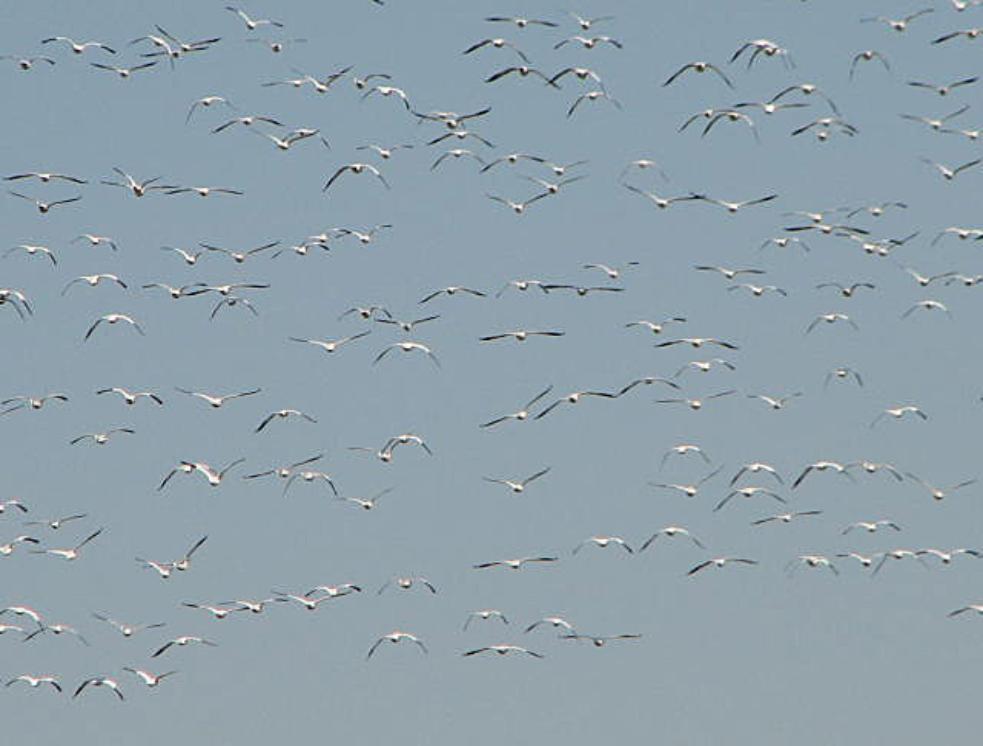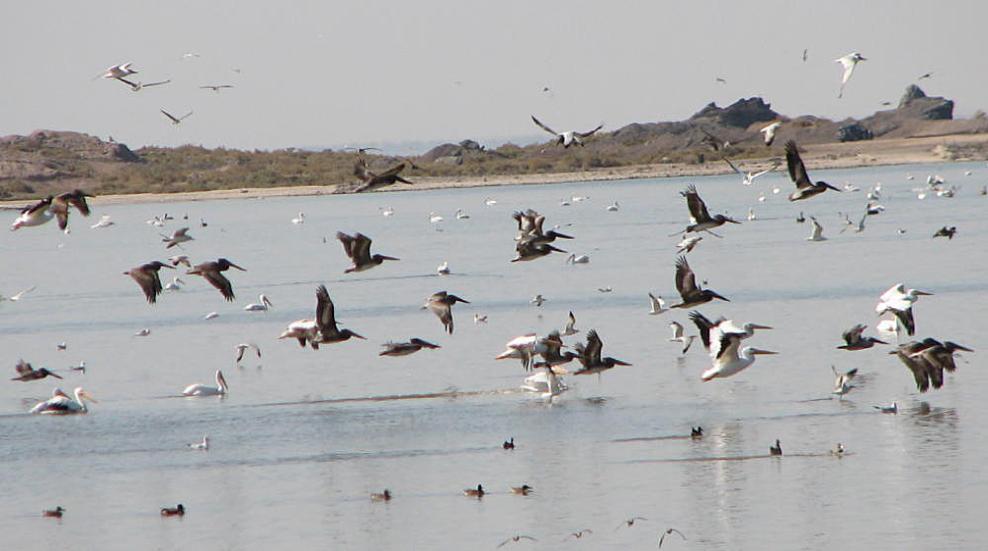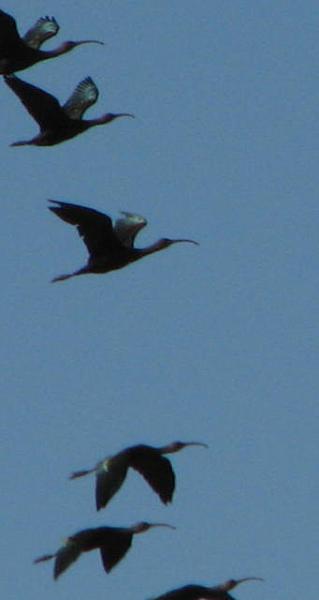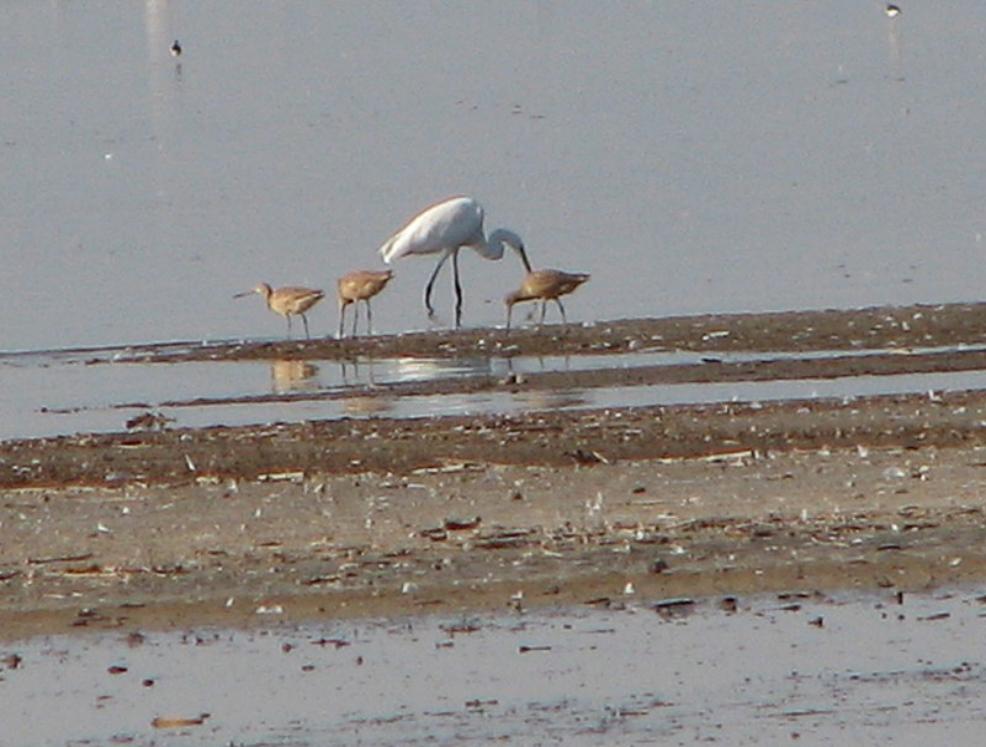| Many Pelicans and Snow Geese at Salton Sea in California |
Before I went to Las Vegas, Nevada to attend my classmate reunion in the second week of November 2006,
I toured Salton Sea National Wildlife Refuge (NWR) in southeast California for bird watching on October 29,
2006.
Salton sea is the largest lake in California. It is about 150 miles southeast of Los Angeles and about 40 miles
southeast of Palm Springs. Salton Sea is an inland saline lake in the Sonoran Desert of extreme southeastern
California. The saline water in Salton Sea is 25% saltier than the oceans. There are lots of fish in this large
lake. It is one of the lowest places in the United States, about 228 feet below sea level (similar to that in
Death Valley). The northern part of Salton Sea is a State Recreation Area, and the southern part of Salton
Sea is the protected National Wildlife Refuge.
Each winter, it is home for the annual Salton Sea Bird Festival, which is usually in February when millions of
migratory birds from north come here for winter. This is a wonderful place for bird watchers to enjoy
watching large number of many different kinds of birds in action. It is estimated that over 1 million visitors
spend time at the Salton Sea each year.
The sample pictures that I took in this tour of Salton Sea NWR are shown in the following.
I toured Salton Sea National Wildlife Refuge (NWR) in southeast California for bird watching on October 29,
2006.
Salton sea is the largest lake in California. It is about 150 miles southeast of Los Angeles and about 40 miles
southeast of Palm Springs. Salton Sea is an inland saline lake in the Sonoran Desert of extreme southeastern
California. The saline water in Salton Sea is 25% saltier than the oceans. There are lots of fish in this large
lake. It is one of the lowest places in the United States, about 228 feet below sea level (similar to that in
Death Valley). The northern part of Salton Sea is a State Recreation Area, and the southern part of Salton
Sea is the protected National Wildlife Refuge.
Each winter, it is home for the annual Salton Sea Bird Festival, which is usually in February when millions of
migratory birds from north come here for winter. This is a wonderful place for bird watchers to enjoy
watching large number of many different kinds of birds in action. It is estimated that over 1 million visitors
spend time at the Salton Sea each year.
The sample pictures that I took in this tour of Salton Sea NWR are shown in the following.

密密麻麻滿天振翅飛翔的全都是雪鵝,令人嘆為觀止!
Many snow geese in flight at Salton Sea National Wildlife Refuge in southeastern California.
Many snow geese in flight at Salton Sea National Wildlife Refuge in southeastern California.

Many snow geese in flight at Salton Sea NWR
Snow geese all over the sky at Salton Sea NWR
On December 4, 2006, I toured Bombay Hook National Wildlife Refuge in Delaware, USA and saw huge number
of snow geese in action as shown on my web page at:
http://www.shltrip.com/Bombay_Hook.html
On March 11, 2011, I visited Middle Creek Wildlife Management Area in
Pennsylvania, USA and saw huge number (about 50,000 according to the Visitor
Center) of snow geese in action as shown on my Travelogue web page at:
http://www.shltrip.com/Snow_Geese_50000_of_Them_All_Over_the_Sky.html
On December 4, 2006, I toured Bombay Hook National Wildlife Refuge in Delaware, USA and saw huge number
of snow geese in action as shown on my web page at:
http://www.shltrip.com/Bombay_Hook.html
On March 11, 2011, I visited Middle Creek Wildlife Management Area in
Pennsylvania, USA and saw huge number (about 50,000 according to the Visitor
Center) of snow geese in action as shown on my Travelogue web page at:
http://www.shltrip.com/Snow_Geese_50000_of_Them_All_Over_the_Sky.html
Large flock of white colored birds in flight and on the water at a distance at Salton Sea NWR
Many brown pelicans (鹈鹕) and some seagulls at Salton Sea NWR. It is seen that brown pelicans are much
larger than seagulls.
larger than seagulls.
Two white pelicans and smaller seagulls and dark colored waterfowl on Salton Sea
Many white pelicans and other dark colored waterfowl at Salton Sea NWR. It is seen that the white pelicans
are much larger than those dark colored waterfowl.
are much larger than those dark colored waterfowl.
Two brown pelicans in flight at Salton Sea NWR
A brown pelican with white head in flight at Salton Sea NWR
Eight white pelicans in flight at Salton Sea NWR
在幾步之遙,便從不毛之地到碧波萬頃百鳥翻飛的 Salton Sea, 當你走過漫漫荒漠,
遇見這個晶瑩的大湖時,心中的喜悅之情,非言語所能形容。
Many brown pelicans, white pelicans and other water fowls in flight and on water at Salton Sea NWR
遇見這個晶瑩的大湖時,心中的喜悅之情,非言語所能形容。
Many brown pelicans, white pelicans and other water fowls in flight and on water at Salton Sea NWR
Several pelicans flying just above water at Salton Sea NWR
Many white and brown pelicans in flight at Salton Sea NWR. In the background, the large lake indeed looks like
sea
sea
White pelicans flying just above water at Salton Sea NWR
A flock of cormorants in flight at Salton Sea NWR
A flock of glossy ibises with curved
long beak in flight at Salton Sea
NWR
long beak in flight at Salton Sea
NWR
A large flock of glossy ibises in flight at Salton Sea NWR
Many seagulls, some shorebirds and other birds at Salton Sea NWR
Many egrets at Salton Sea NWR
Many cattle egrets (牛背鷺) on the farm field near Salton Sea NWR
An egret and three shorebirds at Salton Sea NWR
Two of many quails (鹌鹑) running around the bush near the Visitor Center of Salton Sea NWR
One of many quails running across parking lot near Visitor Center of Salton Sea NWR

One of several different kinds of shorebirds at Salton Sea NWR
One of several roadrunners at Salton Sea NWR
Sonny Bono Salton Sea
National Wildlife Refuge (NWR)
This NWR is composed of two disjunctive units, separated by 18 miles of private lands.
The Unit #2 with a Visitor Center
906 W Sinclair Rd
(Corner of W. Sinclair Road & Gentry Road)
Calipatria, CA 92233 – 9744
E-mail: Christian_Schoneman@fws.gov
Phone Number: 760-348-5278
Website: http://www.fws.gov/Refuges/profiles/index.cfm?id=11631
http://www.fws.gov/saltonsea/
Map: Click here to see Google Map showing location of Unit #2 of Sonny Bono Salton Sea National Wildlife
Refuge
The Unit #1 of this National Wildlife Refuge is nine miles northwest of Westmorland and is off SR 86/78 to go
north on Vendel Road, an unpaved pebble road, for about 5 miles until the end where there is an elevated
observation platform for bird watching. (We saw the huge flock of snow geese when we were on Vendel Road.)
Map: Click here to see Google Map showing location of Unit #1 of Salton Sea National Wildlife Refuge
National Wildlife Refuge (NWR)
This NWR is composed of two disjunctive units, separated by 18 miles of private lands.
The Unit #2 with a Visitor Center
906 W Sinclair Rd
(Corner of W. Sinclair Road & Gentry Road)
Calipatria, CA 92233 – 9744
E-mail: Christian_Schoneman@fws.gov
Phone Number: 760-348-5278
Website: http://www.fws.gov/Refuges/profiles/index.cfm?id=11631
http://www.fws.gov/saltonsea/
Map: Click here to see Google Map showing location of Unit #2 of Sonny Bono Salton Sea National Wildlife
Refuge
The Unit #1 of this National Wildlife Refuge is nine miles northwest of Westmorland and is off SR 86/78 to go
north on Vendel Road, an unpaved pebble road, for about 5 miles until the end where there is an elevated
observation platform for bird watching. (We saw the huge flock of snow geese when we were on Vendel Road.)
Map: Click here to see Google Map showing location of Unit #1 of Salton Sea National Wildlife Refuge
Click here for Home Page to see List of All My Trips and
Three Methods to search my Travelogue website for
web pages of interest to you
Three Methods to search my Travelogue website for
web pages of interest to you
This is the Post Office in the City of Calipatria which is about 4 miles southeast of Salton Sea, both in the
Sonoran desert. The elevation of Calipatria is 184 feet below sea level and is the lowest incorporated city in
western hemisphere. Summer daytime temperatures often exceed 115°F (i.e., 46°C). This is somewhat similar
to Turpan (吐魯番) along the historical Silk Road in XinJiang province in western China. Turpan is known as the
Land of Fire (火洲 ) where people bake their dough cakes by sticking them on the walls of the huts. In Turpan
in summer daytime, the air temperature can reach 47°C and the ground surface temperature is about 70°C
Sonoran desert. The elevation of Calipatria is 184 feet below sea level and is the lowest incorporated city in
western hemisphere. Summer daytime temperatures often exceed 115°F (i.e., 46°C). This is somewhat similar
to Turpan (吐魯番) along the historical Silk Road in XinJiang province in western China. Turpan is known as the
Land of Fire (火洲 ) where people bake their dough cakes by sticking them on the walls of the huts. In Turpan
in summer daytime, the air temperature can reach 47°C and the ground surface temperature is about 70°C
A close up view of the sign on Calipatria Post Office.
When we were driving from Palm Springs to Salton Sea, we saw many date palm trees along the desert
highway. The date fruit clusters on these trees are protected by bags hanging on the trees as shown in these
two pictures.
highway. The date fruit clusters on these trees are protected by bags hanging on the trees as shown in these
two pictures.


While we were doing bird watching near Imperial Dam over Colorado River between California and Arizona, we
saw this black bird on the date cluster, without the covering bag, on a date palm tree.
Winter wildlife watching in Everglade National Park in Florida is also very interesting and enjoyable as shown at
the following web page:
http://www.shltrip.com/Florida_Everglades.html
saw this black bird on the date cluster, without the covering bag, on a date palm tree.
Winter wildlife watching in Everglade National Park in Florida is also very interesting and enjoyable as shown at
the following web page:
http://www.shltrip.com/Florida_Everglades.html
Some companies are considering growing algae in Salton Sea as an alternative energy source. They project
that (1) one acre of algae can produce as much as 20,000 gallons of fuel per year, and (2) If USA puts 15
million acres of desert into algae production, it may produce enough liquid fuel to get USA off the addiction on
oil import from foreign countries.
that (1) one acre of algae can produce as much as 20,000 gallons of fuel per year, and (2) If USA puts 15
million acres of desert into algae production, it may produce enough liquid fuel to get USA off the addiction on
oil import from foreign countries.

























Our 2-week trip from October 26 to November 10, 2006 is a large loop in southeast California, western
Arizona and southern Nevada starting at Los Angeles and ending at Los Angeles. The sequence of
Point-Of-Interest in this 2-week trip is the following:
Los Angeles --> Palm Springs (4 days for touring Palm Springs Aerial Tramway, Wind Turbine Farm, Jenks
Lake, Sonny Bono Salton Sea National Wildlife Refuge (NWR), Joshua Tree National Park and Morongo
Birding Areas) --> Anza Borrego State Park --> Imperial Valley (Painted Gorge, Imperial National Wildlife
Refuge,) --> Cibola NWR --> Havasu NWR and London Bridge --> Laughlin, NV (near Bullhead City, Arizona)
--> Scenic Highway 68, Scenic Highwayway 93, Hoover Dam --> Las Vegas --> Valley of Fire State Park in
Nevada, Mount Charleston, Scenic Highway 158, Hemenway Park --> Class Reunion in Las Vegas (Lake
Mead Cruise, Red Rock National Recreational Area) --> Los Angeles
Arizona and southern Nevada starting at Los Angeles and ending at Los Angeles. The sequence of
Point-Of-Interest in this 2-week trip is the following:
Los Angeles --> Palm Springs (4 days for touring Palm Springs Aerial Tramway, Wind Turbine Farm, Jenks
Lake, Sonny Bono Salton Sea National Wildlife Refuge (NWR), Joshua Tree National Park and Morongo
Birding Areas) --> Anza Borrego State Park --> Imperial Valley (Painted Gorge, Imperial National Wildlife
Refuge,) --> Cibola NWR --> Havasu NWR and London Bridge --> Laughlin, NV (near Bullhead City, Arizona)
--> Scenic Highway 68, Scenic Highwayway 93, Hoover Dam --> Las Vegas --> Valley of Fire State Park in
Nevada, Mount Charleston, Scenic Highway 158, Hemenway Park --> Class Reunion in Las Vegas (Lake
Mead Cruise, Red Rock National Recreational Area) --> Los Angeles
****************************************
In case if you see overlapped lines of text or some lines of text become obscured behind a picture on this web
page, please change the page magnification (zoom) factor to eliminate such problems by pressing these two
keys "Ctrl +" simultaneously or these two keys "Ctrl -" simultaneously. Depending on your PC setting, it may be
necessary to reduce the magnification factor several steps down in order to eliminate the overlap and
obstructed text lines.
Please press the F11 key (Fn key and F11 key on laptop PC) on your keyboard to get full-screen view of
photos and web page. Pressing F11 key again will return to your normal screen with various tool bars.
****************************************
In case if you see overlapped lines of text or some lines of text become obscured behind a picture on this web
page, please change the page magnification (zoom) factor to eliminate such problems by pressing these two
keys "Ctrl +" simultaneously or these two keys "Ctrl -" simultaneously. Depending on your PC setting, it may be
necessary to reduce the magnification factor several steps down in order to eliminate the overlap and
obstructed text lines.
Please press the F11 key (Fn key and F11 key on laptop PC) on your keyboard to get full-screen view of
photos and web page. Pressing F11 key again will return to your normal screen with various tool bars.
****************************************
| 讀萬卷書 行萬里路 |

How I use information age technologies to enhance my enjoyment greatly of sightseeing large driving tour
loop of thousands of miles and of one to two weeks in duration covering many Points of Interest is described
on my web page at:
http://www.shltrip.com/Sightseeing_in_Information_Age.html
loop of thousands of miles and of one to two weeks in duration covering many Points of Interest is described
on my web page at:
http://www.shltrip.com/Sightseeing_in_Information_Age.html